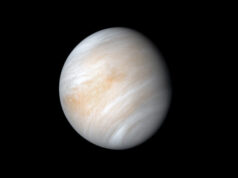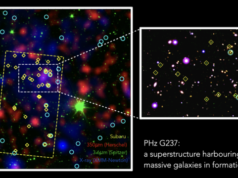Astronomers have detected a stealthy black hole from its effects on an interstellar gas cloud. This intermediate-mass black hole is one of over 100 million quiet black holes expected to be lurking in the galaxy. These results provide a new method to search for other hidden black holes and help us understand the growth and evolution of black holes.
Black holes are objects with such strong gravity that nothing, including light, can escape once it falls beyond the event horizon. Because black holes do not emit light, astronomers must infer their existence from the effects of their gravity on other objects. Black holes range in mass from about five times the mass of the sun to supermassive black holes millions of times the mass of the sun. Astronomers think that small black holes merge and gradually grow into large ones, but no one had ever found an intermediate-mass black hole weighing hundreds or thousands of times the mass of the sun.
A research team led by Shunya Takekawa at the National Astronomical Observatory of Japan noticed HCN-0.009-0.044, a gas cloud moving strangely near the center of the galaxy 25,000 light-years away from Earth in the constellation Sagittarius. They used ALMA (Atacama Large Millimeter/submillimeter Array) to perform high-resolution observations of the cloud and found that it is swirling around a massive invisible object.
Takekawa says, “Detailed kinematic analyses revealed that an enormous mass, 30,000 times that of the sun, was concentrated in a region much smaller than our solar system. This and the lack of any observed object at that location strongly suggests an intermediate-mass black hole. By analyzing other anomalous clouds, we hope to expose other quiet black holes.”
Tomoharu Oka, a professor at Keio University and coleader of the team, adds, “It is significant that this intermediate mass black hole was found only 20 light-years from the supermassive black hole at the galactic center. In the future, it will fall into the supermassive black hole, much like gas is currently falling into it. This supports the merger model of black hole growth.”
Find your dream job in the space industry. Check our Space Job Board »
These results were published as Takekawa et al. “Indication of Another Intermediate-mass Black Hole in the Galactic Center” in The Astrophysical Journal Letters on January 20, 2019.
Provided by: National Institutes of Natural Sciences
More information: Shunya Takekawa et al. Indication of Another Intermediate-mass Black Hole in the Galactic Center. The Astrophysical Journal (2019). DOI: 10.3847/2041-8213/aafb07
Image: Artist’s impression of a gas cloud swirling around a black hole. Credit: NAOJ











